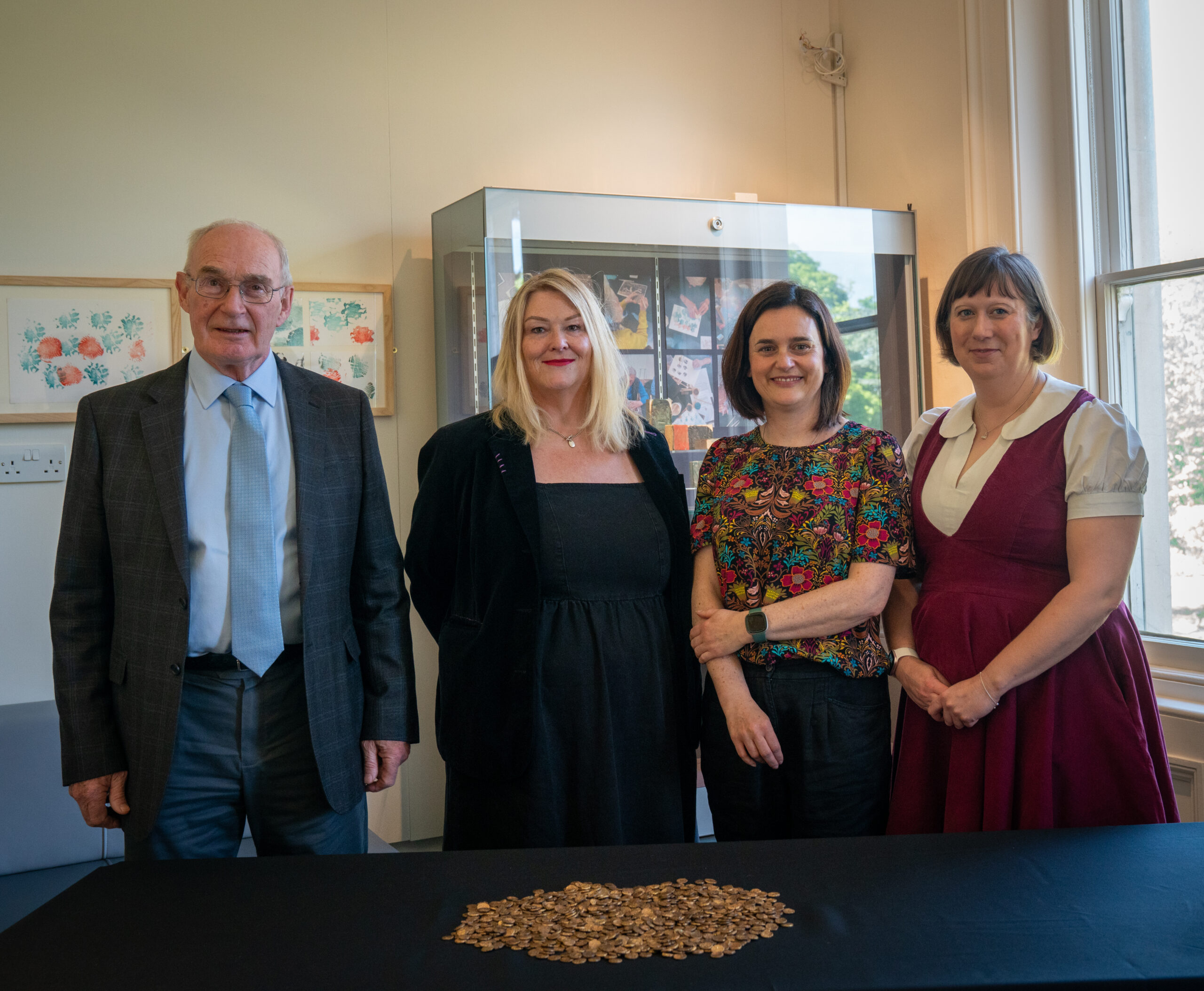Great Baddow Hoard

Additional Information from Museum of Chelmsford
Coin types
The Great Baddow Hoard consists of 933 gold Iron Age coins along with fragments of a possible container or vessel.
930 of the gold coins are Eastern British staters of the ‘Whaddon Chase’ type. These coins were produced in the North Thames region around 60 to 20 BC, and are found in a broad area across Essex, Buckinghamshire, Bedfordshire, Hertfordshire and Essex.
Studies show them to have been produced using one worn obverse die and two reverse dies, which may have originally been used for coins from the Whaddon Chase Hoard (Buckinghamshire) of 1849. The obverse is characterised by an abstract wreath design and the reverse depicts a horse running right.
Each coin is approximately 5.95g. Whilst all 930 of the Eastern British Staters are of the same design and value, each coin does have a slight variation in size, shape and look as a result of Iron Age coin striking processes and the impact of the passage of time.
There are three other single coins of varying types:
- An uninscribed Eastern British quarter stater – 1.39g
- A Continental Gallo-Belgic E uniface stater – c. 60-50BC, 6.24g
- An uninscribed East Anglian gold stater of ‘Norfolk Wolf’ – c. 60-50BC, 6.11g
Fragments of a possible vessel of unknown form were also found with the coins: a copper alloy ring (possibly a vessel rim or binding), fragments of decayed red glass with copper alloy inlay, fragments of copper alloy sheet – some with rivets and rivet holes, and a fragment of organic material (possibly leather).
Circumstances of the find
Due to the uncontrolled excavation of the coins by the finder and the fragmentary nature of the artefacts found alongside them, the archaeological context of the hoard has sadly been diminished. The findspot was returned to by the Finds Liaison Officer for Essex with a group of local experts shortly after the declaration of the find, where they found one additional coin but no further surviving archaeological evidence.
As part of the National Lottery Heritage Fund grant, additional fieldwork in the general location of the findspot will be undertaken from summer 2025.
Findspot and its significance
The exact findspot will not be disclosed but the eastern location of the find, in the village of Great Baddow in Chelmsford, is of interest in our understanding of the movement of Iron Age groupings.
Many of the coins found in the hoard would usually have been found further west. This can be seen in the fact that some of the coins in the Great Baddow Hoard share the same reverse die as coins found in the Whaddon Chase Hoard (found in Buckinghamshire in 1849). That the Great Baddow Hoard was discovered in traditional Trinovantian territory suggests possible dominant movement of the Catuvellauni eastwards at this time.
Additionally, some experts suggest that the sheer number of gold staters being produced in the Eastern region of Britain at this time could be connected with Julius Caesar’s 54BC invasion. It is theorised that the Great Baddow Hoard and other coins may have been intended as a tribute payment to the Roman general following his invasion.
Iron Age tribes in the east of England
Note: For ease we have used the terms Catuvellauni and Trinovantes when referring to known Iron Age groupings in what is now the southeast of England. However, these terms were used by the Roman period administration and, with limited written records by Iron Age groups, there is some uncertainty over their meaning and use in Britain. The term Trinovantes first appears in Julius Caesar’s record of his invasion of Britain in 54BC, while the term Catuvellauni is not mentioned in Roman records until AD43.
The Trinovantes were a ‘tribe’ or ‘grouping’ found in Iron Age Britain. They are the first British tribe to be mentioned in Roman accounts, appearing in Caesar’s record of his invasion of Britain in 54BC. Their territory was located on the north side of the River Thames, covering much of modern-day Essex and parts of Hertfordshire, Suffolk and Greater London.
The Catuvellauni were another ‘tribe’ or ‘grouping’ found in Iron Age Britain. They are first officially mentioned in Roman records in AD43 but were known to exist as an unnamed grouping prior to this. Their territory covered the modern-day counties of Hertfordshire, Bedfordshire and Buckinghamshire, as well as parts of Berkshire, Cambridgeshire, Essex and Greater London. In the years after Julius Caesar’s 54BC invasion of Britain, the Catuvellauni became a dominant tribe, expanding their territory and eventually combining several Iron Age groups to become one of the most powerful tribes in Britain.
The Treasure Act 1996
Under the Treasure Act (www.finds.org.uk/treasure) finders have a legal obligation to report all finds of potential Treasure to the local coroner in the district in which the find was made. The success of the Act is only possible through the work of the Portable Antiquities Scheme, advising finders of their legal obligations, providing advice on the process and writing reports for coroners on Treasure finds.
The Act allows a national or local museum to acquire Treasure finds for public benefit. If this happens a reward is paid, which is (normally) shared equally between the finder and landowner. Interested parties may wish to waive their right to a reward, enabling museums to acquire finds at reduced or no cost. Rewards are fixed at the full market value of the finds, determined by the Secretary of State upon the advice of an independent panel of experts, known as the Treasure Valuation Committee.
The administration of the Treasure process is undertaken at the British Museum. This work involves the preparation of Treasure cases for coroners’ inquests, providing the secretariat for the Treasure Valuation Committee, and handling disclaimed cases and the payment of rewards.
Find more information at Chelmsford Museum’s website: https://www.chelmsford.gov.uk/museums/collections/the-great-baddow-hoard
